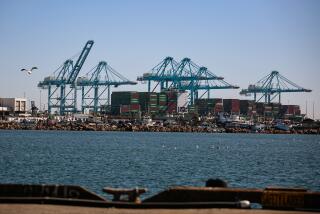Worker Had Complained About Crane Operator
- Share via
Two days before a crane operator was involved in an accident that killed six workers and injured six others at the National Steel & Shipbuilding Co., an iron worker complained to a supervisor that the operator was “real wild” when moving the crane’s boom.
Robin Cullum, 31, a 9-year veteran at Nassco, said she complained to a rigging supervisor when crane operator Hugh Humphrey swung a pallet loaded with a life raft about two feet above her head without warning. The two were working on the Navy hospital ship Comfort at the time of the incident, Cullum said. She declined to reveal the name of the supervisor, but said she reported the incident to the head of her union after the July 10 accident.
Manuel Ruiz, financial secretary/treasurer of the Iron Workers Union, Local 627, confirmed that Cullum reported the details of the incident to him.
“She did her job. She brought it to the attention of the supervisor. It’s the supervisor’s responsibility to see that this is corrected,” Ruiz said.
Cullum said the incident left her shaken.
‘Wild With That Crane’
“He’s real wild with that crane,” she said. “He came pretty close to tearing my head off. I flat told him (the supervisor) that he (the operator) was going to kill somebody.”
Humphrey, 65, was reached at his Chula Vista home but said he would have no comment on the incident.
Fred Hallett, Nassco vice president and spokesman, said: “I have not heard anything about it. But I would strongly request that she talk to the investigative team. If she has some evidence, she should come forward with it.”
The team of investigators, composed of 10 representatives from the unions, Nassco, Navy and the federal Occupational Safety and Health Administration, has refused to comment on the investigation of the accident, which occurred shortly after midnight July 10 when a steel personnel basket filled with 12 workers plunged to the ground as it was being lowered by the crane operated by Humphrey. The basket struck a corner on the Navy supply ship USS Sacramento, which was undergoing an overhaul, and dumped the workers about 30 feet to one of the ship’s decks.
Cullum, who was interviewed last week in her El Cajon apartment, said that was not the first unpleasant experience she has had with Humphrey. The two have jobs that normally keep them at different ends of the shipyard, and Cullum said she does not know what Humphrey looks like. Nevertheless, the few contacts she has had with Humphrey have been unnerving, she said.
Survived Another Accident
“The only contact I’ve had with him is when he’s lifting something when I’m around. On July 1, a rigger had to chase down a load that Humphrey was lifting for me because it was swinging wildly,” Cullum said.
Cullum survived another Nassco shipyard accident in 1980 that left two men dead when they were felled by argon gas in the hold of a ship. She and another woman were overcome by the gas when they attempted to rescue the men but escaped serious injury. Humphrey was not involved in the accident.
In the incident that occurred two days before the July 10 accident, Cullum said there was no warning whistle or horn sounded while the load was being moved overhead. Cullum and officials from other unions who asked not be identified said safety rules are often skirted by workers when loads are being moved by cranes.
“Safety regulations require that a rigger walk below the load, blowing a whistle to alert workers that a load is moving overhead,” said one union official who until recently worked at the shipyard for many years. “In addition, the crane is also required to sound a horn, but these things are routinely ignored. But you can’t blame the company for this because this is the workers’ doing.”
Different Version of Rules
After consulting with a company safety specialist about the regulations, Hallett offered a slightly different version of Nassco’s safety rules. He said the regulations allow riggers and operators to use their discretion over whether to sound a warning or not.
“The required procedure is that they blow the crane horn and rigger’s whistle if anybody is in the general vicinity or in danger of being hurt as we’re lifting heavy loads,” said Hallett, citing the crane safety regulations.
Until recently, Humphrey had been assigned to conventionally powered hydraulic cranes that move on the ground. The crane involved in the accident that killed the six shipyard workers is commonly called a gantry. Gantrys run on a fixed track along the pier and are powered by a diesel engine that generates electricity to run the boom.
Hallett said Humphrey had operated the gantry for less than a year at the time of the accident but was fully qualified to operate the machine.
“I believe that he had not operated the gantry for the last 13 years,” Hallett said. “It’s my understanding that it was within the past year that he started to work on the crane.”
Qualified to Operate Gantry
Don Kidd, district representative for the Operating Engineers International Union, Local 12--Humphrey’s union--said Humphrey had been found qualified by Nassco to operate the gantry.
Hallett said Humphrey had been trained by the union and had received further training by the company to operate the gantry.
In describing the accident, Hallett said the basket continued falling after it struck the ship, landing on top of the workers. The day of the accident was also Humphrey’s first day working on the ship, Hallett said.
Humphrey is now on a paid leave of absence. If he returns to work before the investigation is completed, Nassco officials will not allow him to operate a crane until investigators determine the cause of the accident.
Hallett declined to comment about Humphrey’s job status if the investigation reveals that Humphrey is to blame for the accident.
Slow Investigation
Meanwhile, the investigation into the accident has gotten off to a slow and painstaking start. On the day of the accident, Nassco officials predicted that the investigation would begin the following Monday and an official cause for the tragedy would be released later in the week.
On Friday, Hallett said the crane would probably not be dismantled and inspected until next week and the cause of the accident not known until about a month later. The team of investigators, Hallett said, is still awaiting the arrival of experts on the crane’s gear and braking system before testing the crane.
“The team is going through the planning stages, how to test and dismantle the crane. They will review their plans with the experts. . . . The whole team is taking the posture that it is more important to bring in the right people to conduct the investigation,” Hallett said.
After the investigation is completed, OSHA will conduct “a complete safety review of the shipyard,” Hallett said.
“OSHA will do a complete review of the rest of the yard to see if they can advise us about any potentially unsafe conditions. We welcome this review,” said Hallett, who declined to comment further.
Eleven workers have died in shipyard accidents at Nassco since 1980. Humphrey was involved in another fatal accident last year, when a worker died after he was struck on the head with a beam that fell from a load that was being moved by a hydraulic crane that was operated by Humphrey. However, Humphrey was cleared of any responsibility when Nassco officials determined that the load had been improperly rigged.
More to Read
Sign up for Essential California
The most important California stories and recommendations in your inbox every morning.
You may occasionally receive promotional content from the Los Angeles Times.













